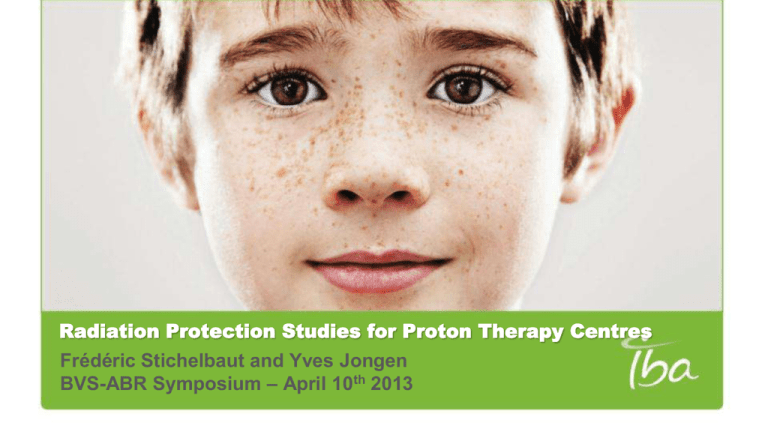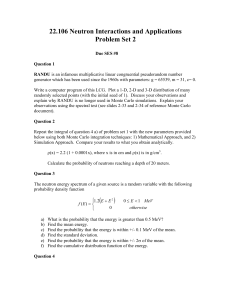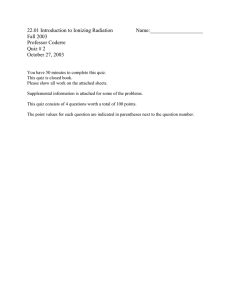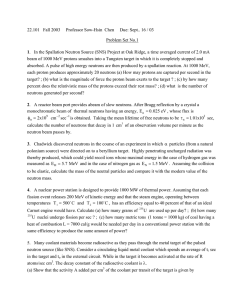Radiation Protection Studies for Proton Therapy Centres Frédéric
advertisement

Radiation Protection Studies for Proton Therapy Centres Frédéric Stichelbaut and Yves Jongen BVS-ABR Symposium – April 10th 2013 Outline Introduction Radiation sources Neutron attenuation in concrete Shielding design for a PT centre Monte Carlo code validation Neutron-induced activation Conclusions Protect, Enhance, and Save Lives -2- Hadron/Proton Therapy Advantages Hadron interactions with matter: Maximal energy losses at the end of hadron range (Bragg peak); Particle range changing with energy 1H: 70 MeV to 230 MeV (32 cm in water) Highly ionizing particles. Advantages wrt classical RT: Precise control of the dose delivered to the tumor Reduction of dose delivered to healthy tissue, sparing critical organs located behind tumor. Larger radiobiological efficiency (RBE ~ 2 to 3 for 12C ions). Protect, Enhance, and Save Lives -3- Proton Therapy Center by IBA IBA has installed its first PT system at Massachusetts General Hospital (MGH) in Boston (2000). IBA is now the world leader in Proton Therapy with more than 20 centers already installed or in construction in USA (10), Europe (8) and Asia (3). Protect, Enhance, and Save Lives -4- ProteusONE: Compact PT System 12 meters Single-room system equipped with a superconducting cyclotron and a compact gantry. 18 meters Protect, Enhance, and Save Lives -5- Radiation Sources in Cyclotron & Treatment Rooms Neutrons and photons are produced at various locations along beam path when protons hit matter Cyclotron room Fixed beam room Gantry rooms Energy Selection System (ESS) Cyclotron (230 MeV on Cu/Fe) Degrader (230 MeV on C) Collimator (70-230 MeV on Ta) Divergence slits (70-230 MeV on Ni) Momentum slit (70-230 MeV on Ni) Nozzle (70-230 MeV on Brass) 6 Protect, Enhance, and Save Lives -6- Patient (70-230 MeV on Tissue) Secondary Radiation (1) Yields of secondary particles depend on beam energy and target materials Protect, Enhance, and Save Lives -7- Secondary Radiation (2) Production of secondary neutrons: • • Intranuclear cascade high-energy neutrons, mostly forward emission Target nuclei evaporation neutrons < 10 MeV, isotropic emission M.M. Meier et al, Nucl. Sci. Eng. 104, 339 (1990) Protect, Enhance, and Save Lives -8- MCNPX simulation Neutron Attenuation in Concrete (1) Proton Interactions with matter: Secondary neutrons with energies up to 230 MeV Continuous energy spectra and strong Q variations For a wide and monoenergetic neutron beam traversing a shielding with thickness z: H(z) = H0 e-z/l NCRP-144: Radiation Protection for Particle Accelerator Facilities (2005) 9 Protect, Enhance, and Save Lives -9- Neutron Attenuation in Concrete (2) H(z) = H0 10-z/TVT TVT0 TVTe Strong variation of TVT0 with Q due to differences in energy spectra. TVT0 TVTe because of neutron spectrum hardening with shielding depth. 10 Protect, Enhance, and Save Lives - 10 - Monte Carlo Transport Codes General purpose Monte Carlo (MC) codes allow the transport of electrons, photons, neutrons, protons and heavy ions in matter from low energy (1 keV) to the TeV range: MCNPX – FLUKA – GEANT4 – PHITS These codes simulate all possible interactions + generate and transport secondary particles. Proton and neutron transport in MCNPX (Mix&Match): Based on nuclear database LA150 up to 150 MeV Based on nuclear models above 150 MeV Various intranuclear cascade and evaporation models available in MCNPX 2.7.0 (Bertini, INCL4, CEM03) Protect, Enhance, and Save Lives - 11 - Shielding Design for PT Centre 3D modelling of whole facility using MCNPX: cyclotron room and treatment rooms. Development of a patient case mix based upon clinical requirements. Conversion to beam data set of beam energies and workloads. Simulation of all major radiation sources for each clinical indication and computation of resulting ambient dose equivalent H*(10) or effective dose E(AP), using ICRP-74 fluence-to-dose conversion factors for neutrons and photons. Sum of all radiation sources and clinical indications to determine the annual H*(10) values. Determination of shielding thicknesses based upon local regulations for controled and public areas. Protect, Enhance, and Save Lives - 13 - PT Centre Modelling with MCNPX (1) GTR FBR C230 ESS Eye room Y X Protect, Enhance, and Save Lives 14 - 14 - PT Centre Modelling with MCNPX (2) GTR Cyclotron Room FBR Z X Protect, Enhance, and Save Lives 15 - 15 - Cyclotron Room: Side Wall (1) (2) (2) Public limit (1) Public limit 16 Protect, Enhance, and Save Lives - 16 - Gantry Room: External Wall (1) (2) Public limit (2) Beam (1) Public limit 17 Protect, Enhance, and Save Lives - 17 - Validation of MC Codes Shielding design of our PT centres relies mostly on MC simulations using MCNPX. Validation of these simulations: Benchmarking of MCNPX for the production of secondary neutrons using LANL data. Measurements of ambient dose equivalents around PT equipment using wide-energy range neutron detectors (FREDONE project - ISIB-ULB-IBA collaboration) Protect, Enhance, and Save Lives - 18 - MC Validation: Neutron Generation (1) Secondary neutron yields measured by Meier’s team at LANL: • • • Proton beams 113, 256, 597 and 800 MeV Stopping-length and thin targets Be, B, C, Al, Fe, W, Pb, 238U Measured data available in EXFOR database M.M. Meier et al, Nucl. Sci. Eng. 110, 289 (1992) Protect, Enhance, and Save Lives - 19 - MC Validation: Neutron Generation (2) Comparison of energy-integrated yields obtained for 256 MeV protons impinging on various thick and thin targets Protect, Enhance, and Save Lives - 20 - MC Validation: Neutron Detection (1) Special neutron detector needed to measure H*(10) with high-energy neutrons WENDI-2 from Thermo Scientific able to detect neutrons up to 5 GeV. WENDI-2 Andersson-Braun Eberline Tungsten powder shell to generate (n,xn’) reactions Protect, Enhance, and Save Lives - 21 - MC Validation: Neutron Detection (2) • • Measurements performed at WPE in Essen, Germany. Comparison of ambient dose equivalent H*(10) measured along cyclotron access maze and MCNPX prediction. Protect, Enhance, and Save Lives - 22 - Activation Studies Neutron-induced activation processes: Inelastic collisions (spallation processes) Neutron capture (n,g) MC codes are also very usefull for these activation studies: Air and cooling water activation release strategy. Shielding concrete activation building decommissioning. Activation of PT components (Cyclotron, magnets, beam shaping devices) personal radioprotection and long-term decommissioning. Codes such as FLUKA and PHITS allow the prediction of the whole history, from nuclear reactions to specific activities or dose rates after some cooling period. Protect, Enhance, and Save Lives - 23 - Conclusions Proton therapy offers significant improvements in cancer therapy compared to classical radiotherapy. Interaction of medium-energy protons leads to the production of complex fields of secondary neutrons and photons. General purpose Monte Carlo simulation codes are ideal tools to deal with these mixed fields for radioprotection studies: Shielding design for PT facilities Neutron-induced activation mechanisms MC benchmarking generally shows good agreement between MC predictions and measured data. Protect, Enhance, and Save Lives - 24 - Thank you




